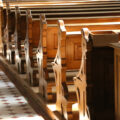Does the Church of Sweden have what it takes to become inclusive to the Sami?
Does the Church of Sweden have what it takes to become inclusive to the Sami?
After centuries of tension, in recent years the Church of Sweden and the Sami communities have started a process of reconciliation. From newly translated prayers to study groups for young Sami, what will the Church and the Sami need to do to become an important part of each other’s life?
In January 2021, the translation of the hymnal into Northern Sami received a warm welcome.[1] [2] This newly published translation is part of an ongoing process of reconciliation between the Church of Sweden and the Sami population. The Sami are one of the five national minorities in Sweden, together with the Roma, the Jews, the inhabitants of Tornedalen, and the Finnish-speaking minority.[3] Historically, the Church has not always been kind to minorities. When it comes to the Sami in particular, the Church historically supported boarding schools separating Sami children from their parents. It also contributed to racial biological investigations by facilitating the study of Sami and their burial remains, which were in some cases taken from ancestral burial grounds.[4] [5]
In 2011, the Church started an investigation of its past actions towards the Sami. The work resulted, among other things, in a white paper that was published in 2016.[6] [7] [8] [9] In 2019, the Church consulted the Sami Council in the Church of Sweden and decided to prepare an official apology to the Sami – one of the steps in the way to an improved relationship between the two.[10] [11] [12] [13]
How much of this work has resulted in practical changes on a day-to-day basis? What needs to be done for the Church and the Sami to share a common future?.
Practical steps or wishful thinking?
In recent years, the Church of Sweden has started a number of different activities focusing on the culture and spirituality of the Sami. The majority of the projects focus on the regions of northern Sweden, where most Sami live.[14] At the same time, on a national level, the Church of Sweden supports initiatives connected to the repatriation of Sami human remains, creates confirmation study groups for young Sami, translates the common worship liturgy book into the Sami languages, starts investigations, and publishes books on the history of Sami and their presence in the Church.[15] [16] [17] [18] These initiatives show an interest in including the Sami in the life of the Church and a will to make amends for the (violent) religious oppression that the Sami experienced at the hands of religious authorities.[19] [20]
After drafting an official apology to be presented in 2021 and 2022, the Church budgeted 40 million krona in order to promote cooperation between the Sami and the Church between 2022 and 2031.[21] [22] Preaching the gospel in the Sami language, spreading the knowledge about the abuses of the Church towards the Sami, and helping young Sami to strengthen their identity are examples of the practical steps the Church plans to take in the coming ten years.[23] Will these steps be enough to change the relationship between the two on a grass-root level or will they remain examples of wishful thinking? Let us look at some of the possible pitfalls in this process of reconciliation and integration.
On whose terms?
The translation of the common worship liturgy book and the hymnal, together with the 10-year budget, are positive steps towards an increased awareness of Sami rights and Sami spirituality. Summarising the words of the chairperson for the Sami Council in the Church of Sweden and member of the Sami Parliament, Ingrid Inga, the translations make the presence of Sami and their spirituality visible within the (liturgical) life of the Church of Sweden.[24] [25] Similarly, the official apology will hopefully mark the starting point for long-term cooperation, with Sami religion and spirituality enriching the Church of Sweden.[26] In addition, the 10-year budget might answer the need for long-term financial support for activities involving young Sami, such as confirmation groups.[27]
What is perhaps even more important, however, is that the Church takes into account the needs and wishes of Sami communities when planning its support. Ingrid Inga stresses the need to find priests and deacons that speak the Sami languages. Among other things, she also suggests study exchanges between the priest seminaries and Sami education centres.[28] When discussing Church support for the repatriation of human remains, the Sami parliament stated that church burials should not be seen as the primary goal, but rather discussed on a case-to-case basis. Instead, the remains of people who lived before the introduction of Christianity should be treated according to the time in which they lived.[29] This example shows the importance of letting Sami communities shape their relationship to the Church on their own accord, especially when Sami traditions differentiate themselves from, or even precede, Christian ones. Otherwise, there is a risk of imposing measures that do not align with the Sami communities and the needs they express. For this reason, ongoing dialogue between the dioceses and the Sami representatives is crucial to the process.[30]
Going forward while looking back
The fact that the Church of Sweden has taken both official measures and practical steps to include the Sami culture, spirituality, and languages is a necessary starting point for a common future. The reactions of the Sami representatives have been positive, even though there is not enough data yet to discuss how the different steps have changed the everyday life of Sami communities. It is important, however, that all these initiatives respect the needs and wishes of the Sami communities, in order to avoid repeating the errors of a past where the voice of the Sami was unheard and neglected.
Our team of analysts conducts research on topics relating to religion and society. In the past month, the topics of traditions, tension, and leadership were trending. Find out their relationships on the EARS Dashboard.
Sources
[1] Premiär för nordsamiska psalmboken! | Luleå stift, Svenska kyrkan
[2] Glädje över samisk psalmbok – nu behövs fler som kan använda den
[4] Kyrkans ursäkt till samer följs av förändring
[5] Svenska kyrkan och rasbiologin
[6] Svenska kyrkan ber om ursäkt
[8] De historiska relationerna mellan Svenska kyrkan och samerna. En vetenskaplig antologi. Band 1.
[9] De historiska relationerna mellan svenska kyrkan och samerna. En vetenskaplig antologi. Band 2
[10] Svenska kyrkan ber om ursäkt
[11] Svenska kyrkan ber om ursäkt
[12] The Church of Sweden and the Sami – a White Paper Project
[13] Officiell ursäkt ska framföras till det samiska folket
[14] Glädje över samisk psalmbok – nu behövs fler som kan använda den
[15] Bakgrund: Repatriering av samiska kvarlevor
[16] Kyrkohandboken på minoritetsspråk tas i bruk
[17] Konfirmation i annorlunda format under pandemin
[18] Samiska frågor i Svenska Kyrkan
[19] Förtryckta samer har förvandlats till förebilder
[20] Kyrkans ursäkt till samer följs av förändring
[21] Åtta åtaganden i försoningsarbetet med samiska folket
[22] Kyrkans ursäkt till samer följs av förändring
[23] Åtta åtaganden i försoningsarbetet med samiska folket
[24] Glädje över samisk psalmbok – nu behövs fler som kan använda den
[25] Kyrkohandboken på minoritetsspråk tas i bruk
[26] Officiell ursäkt ska framföras till det samiska folket
[27] Konfirmation i annorlunda format under pandemin
[28] Glädje över samisk psalmbok – nu behövs fler som kan använda den
[29] Bakgrund: Repatriering av samiska kvarlevor
[30] Så ska Svenska kyrkan arbeta med försoningen med samerna






